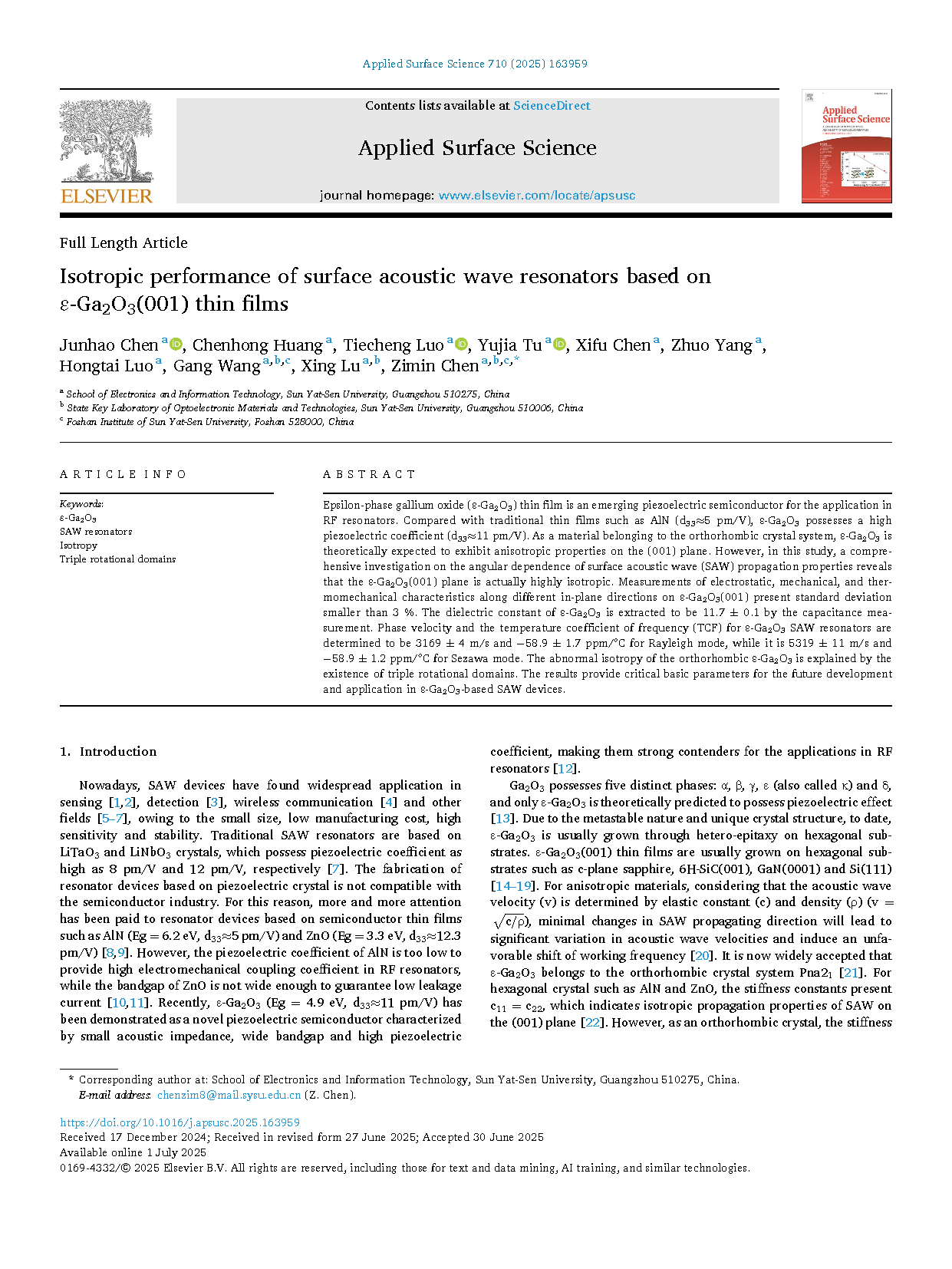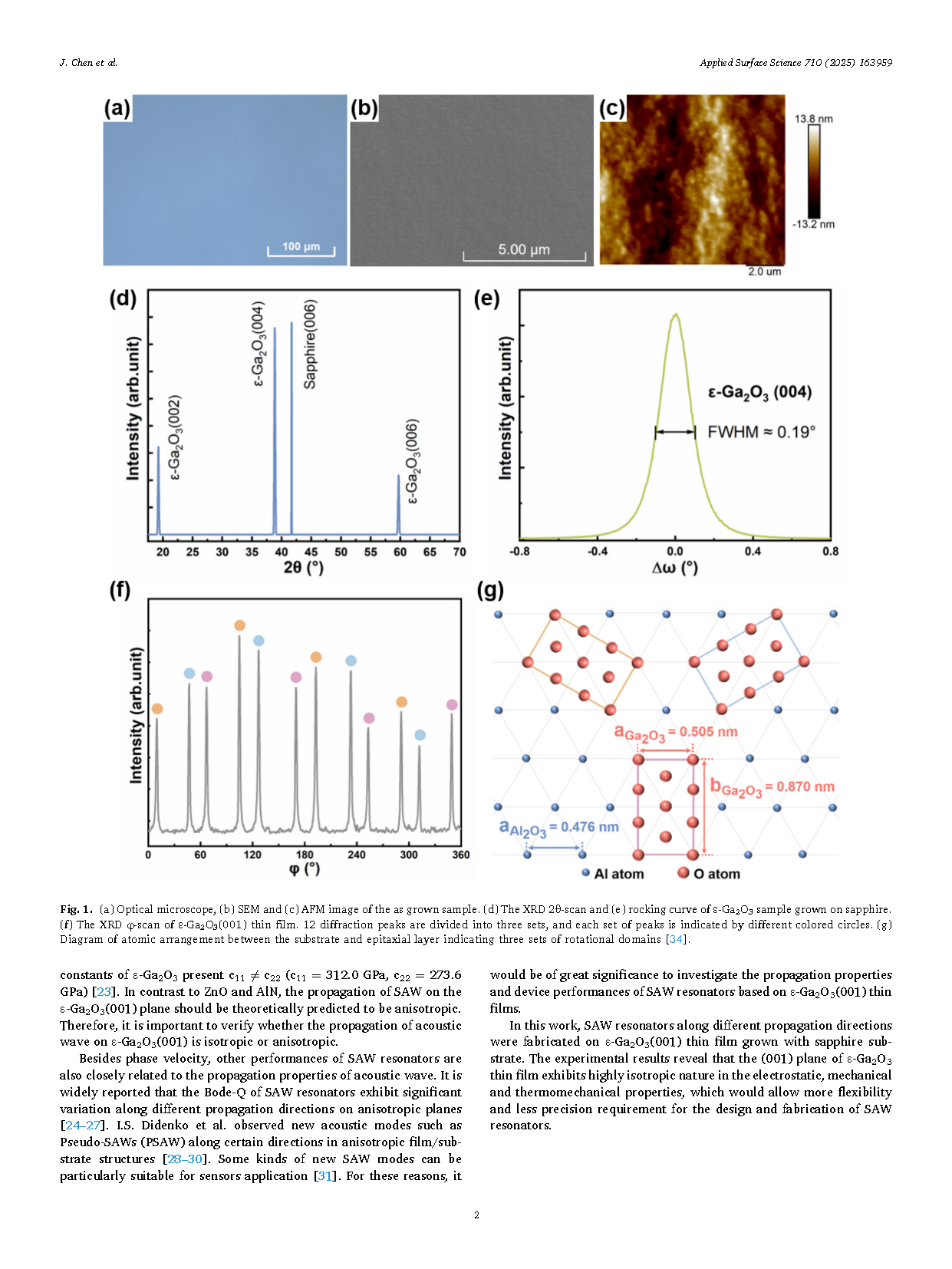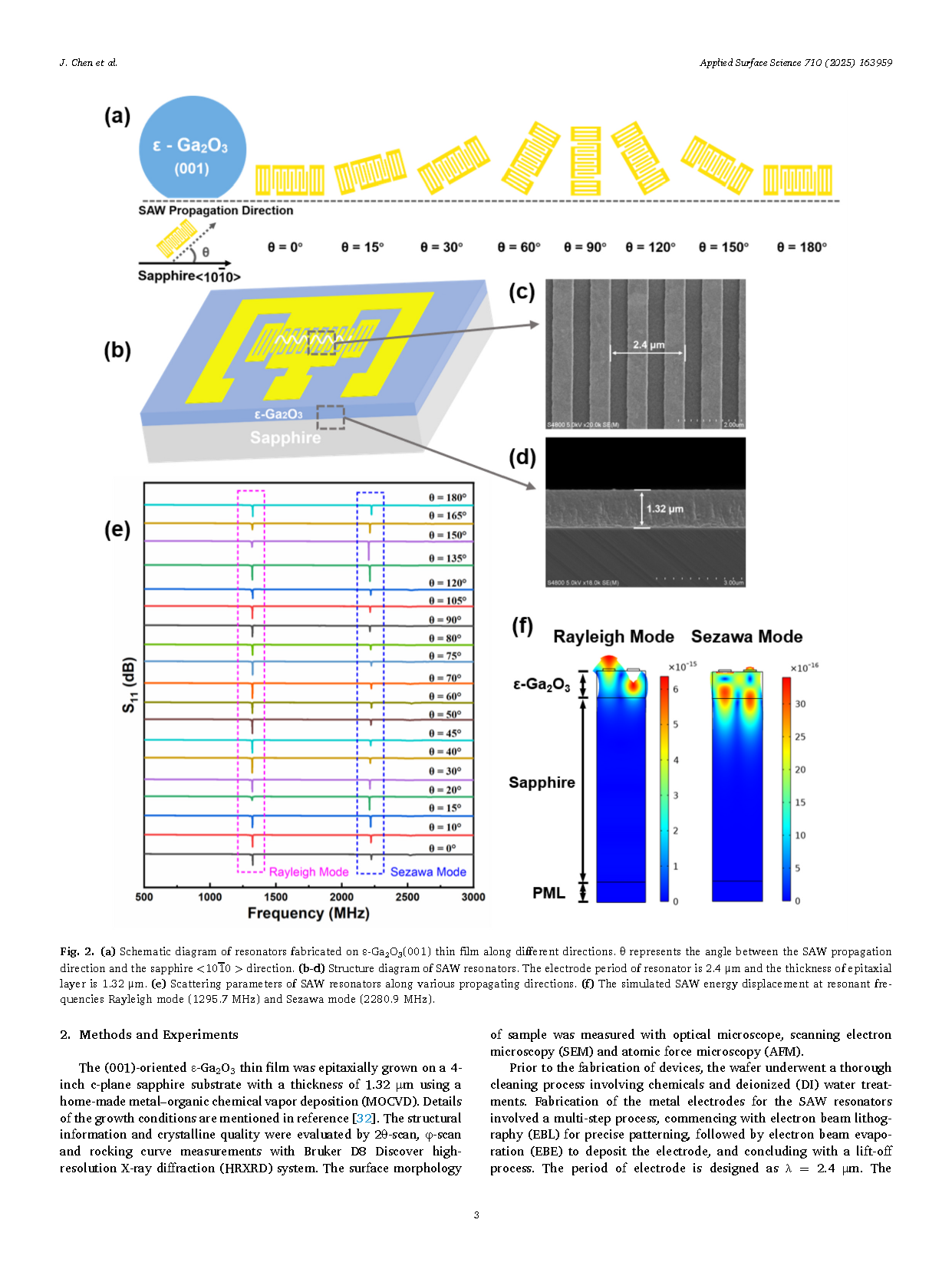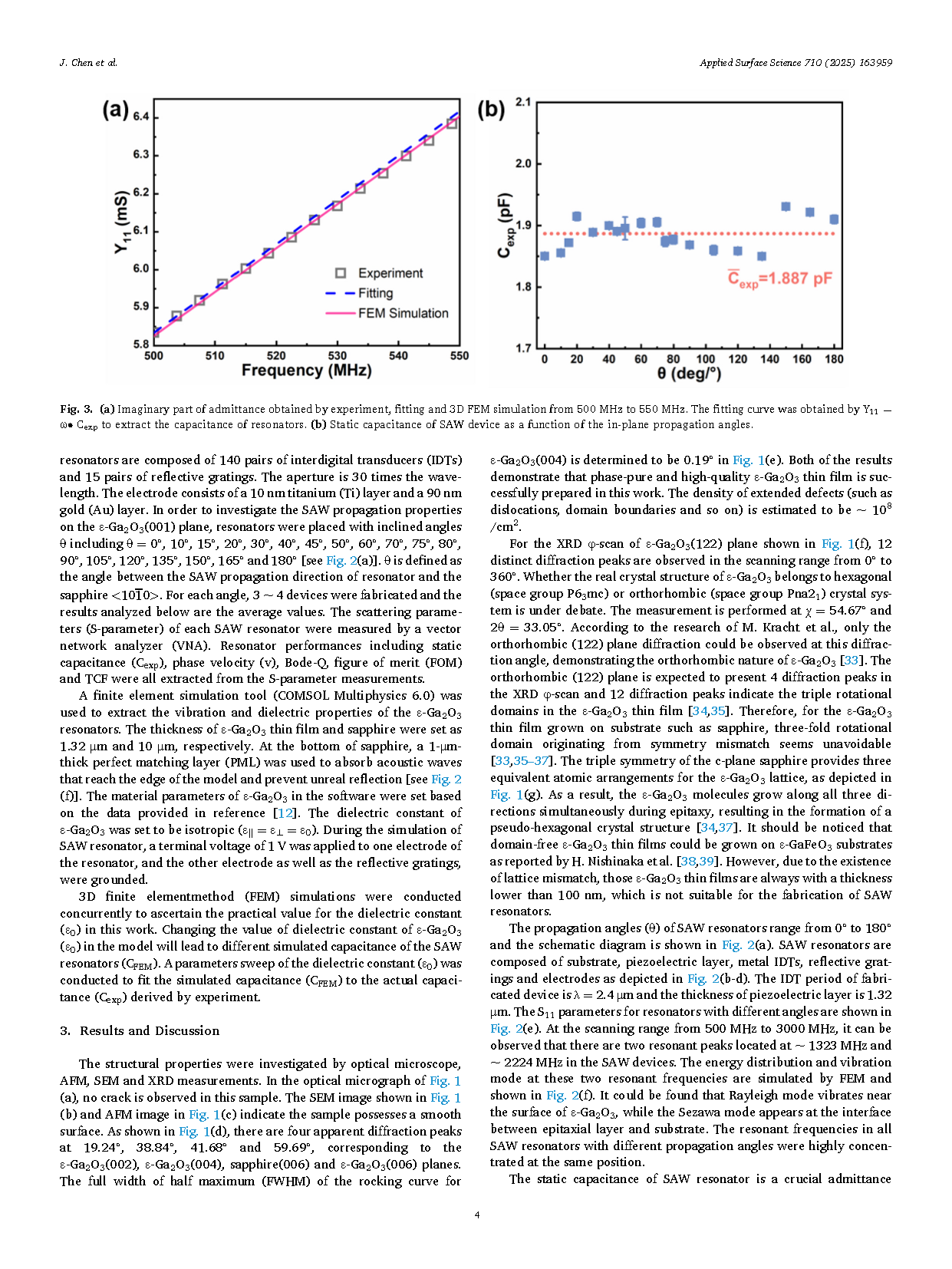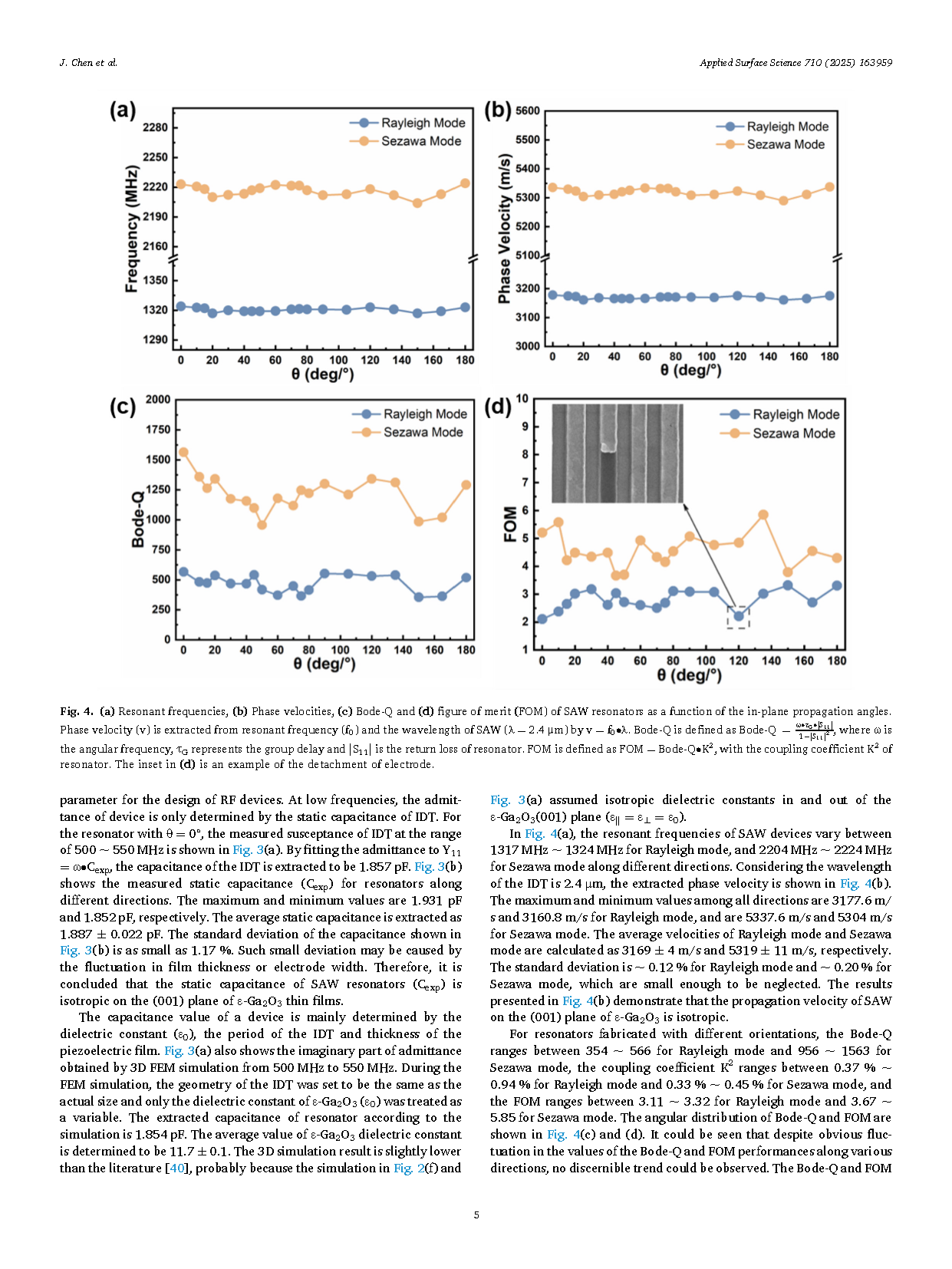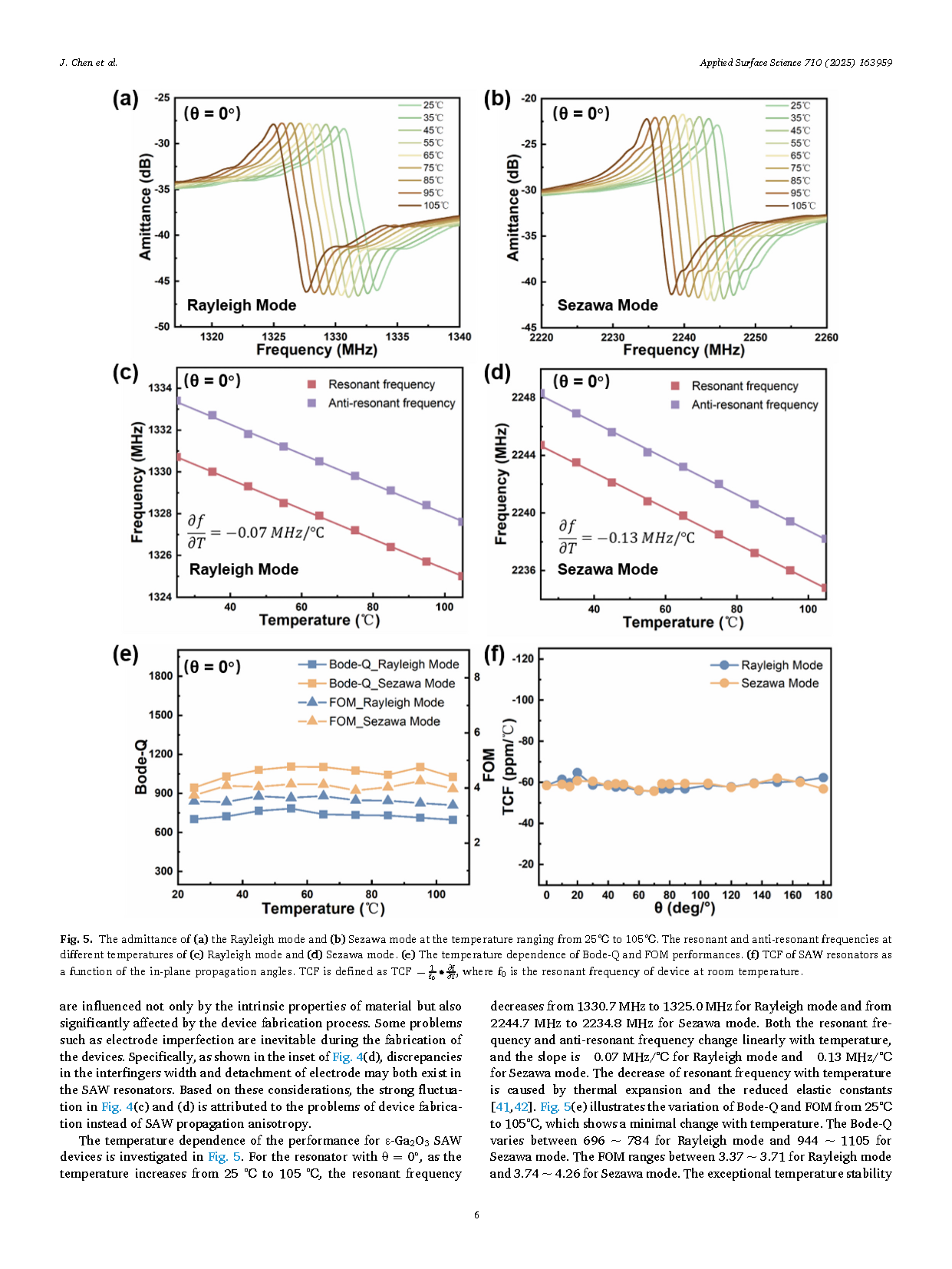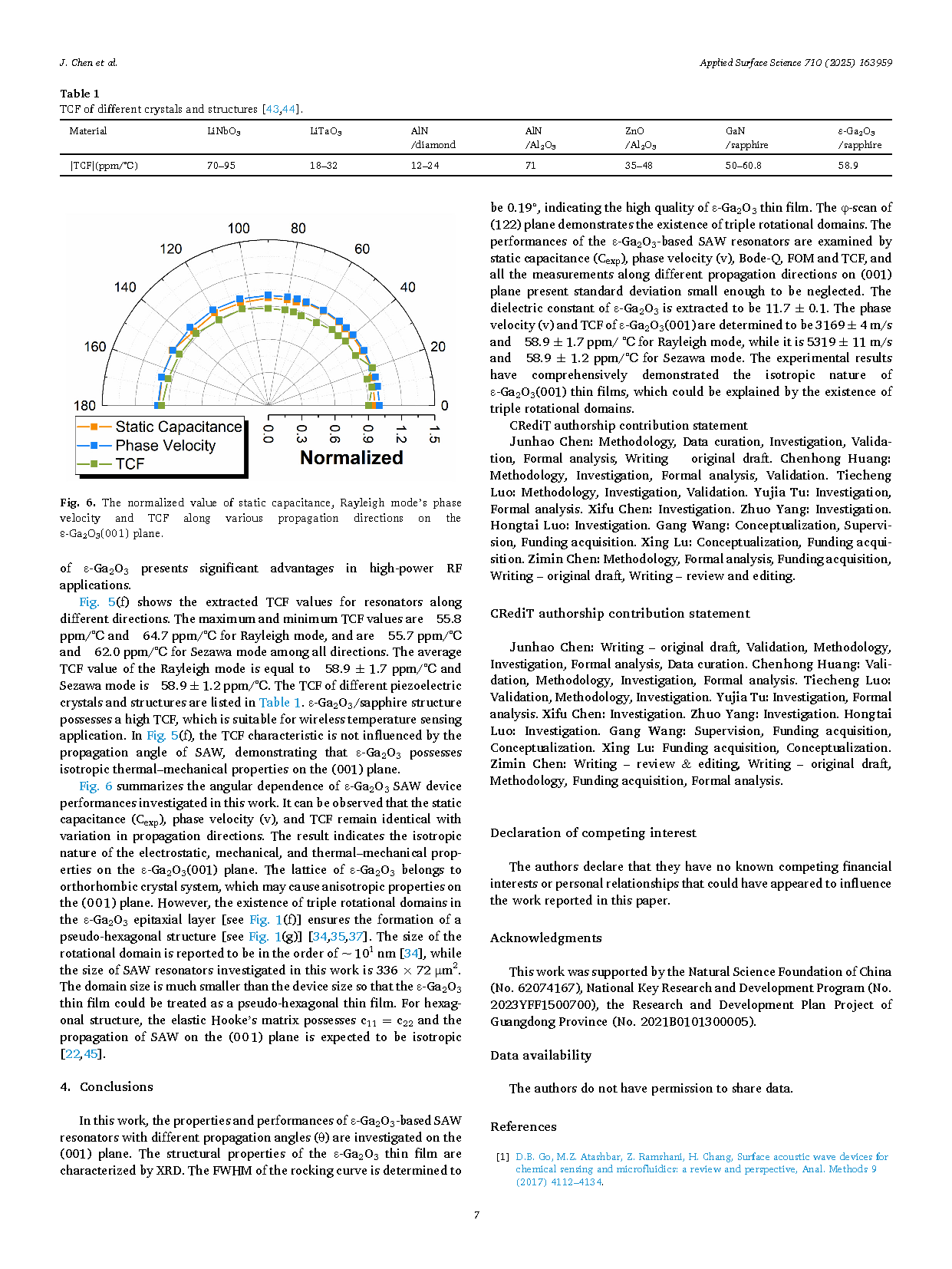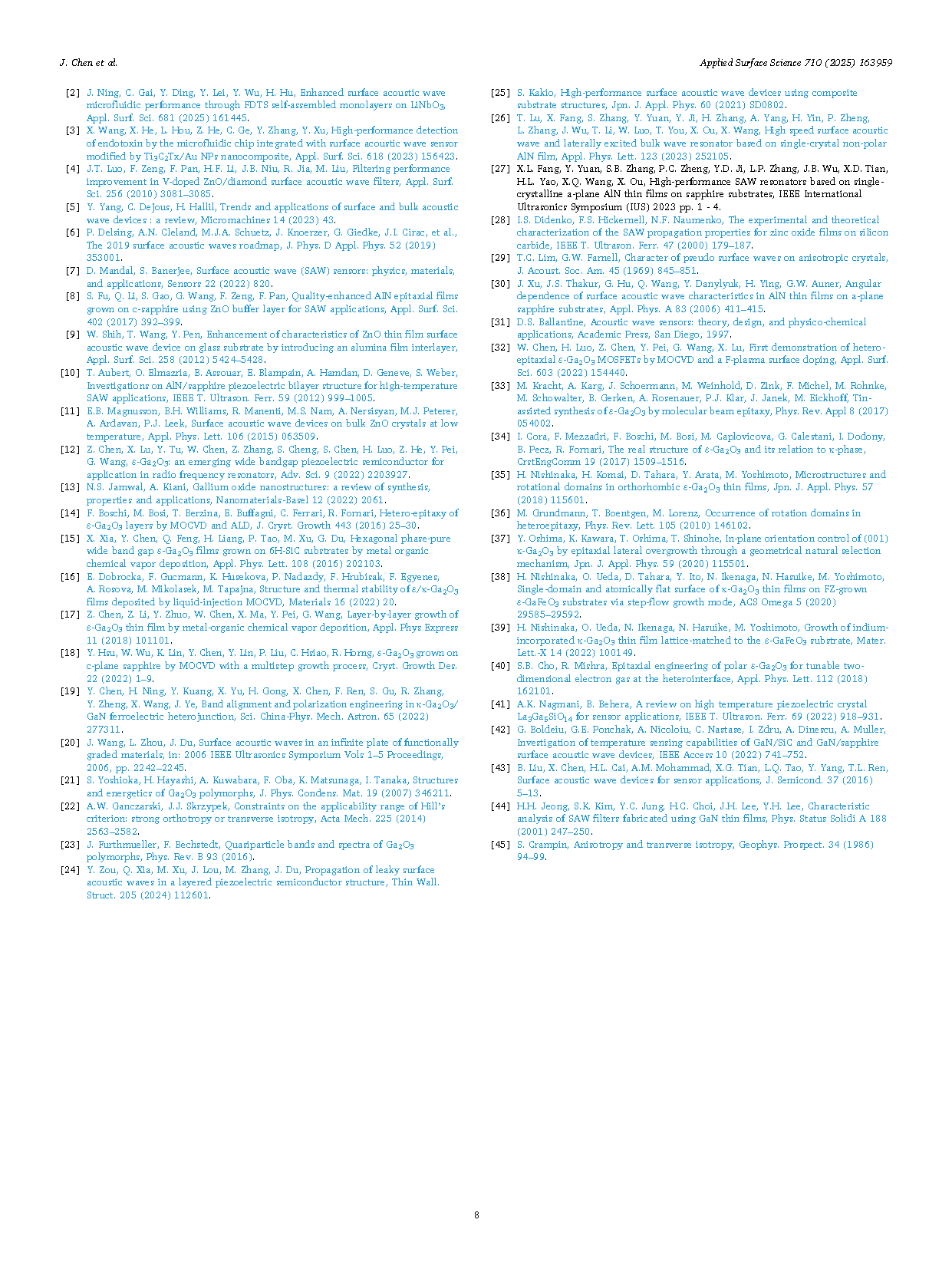
【Domestic Papers】Isotropic performance of surface acoustic wave resonators based on ε-Ga₂O₃(001) thin films
日期:2025-07-23阅读:143
Researchers from the Sun Yat-sen University have published a dissertation titled " Isotropic performance of surface acoustic wave resonators based on ε-Ga2O3(001) thin films" in Applied Surface Science.
Project Support
This work was supported by the Natural Science Foundation of China(No. 62074167), National Key Research and Development Program (No.2023YFF1500700), the Research and Development Plan Project of Guangdong Province (No. 2021B0101300005).
Background
Nowadays, SAW devices have found widespread application in sensing, detection, wireless communication and other fields, owing to the small size, low manufacturing cost, high sensitivity and stability. more and more attention has been paid to resonator devices based on semiconductor thin films such as AlN (Eg = 6.2 eV, d33≈5 pm/V) and ZnO (Eg = 3.3 eV, d33≈12.3 pm/V) . However, the piezoelectric coefficient of AlN is too low to provide high electromechanical coupling coefficient in RF resonators, while the bandgap of ZnO is not wide enough to guarantee low leakage current. Recently, ε-Ga2O3 (Eg = 4.9 eV, d33≈11 pm/V) has been demonstrated as a novel piezoelectric semiconductor characterized by small acoustic impedance, wide bandgap and high piezoelectric coefficient, making them strong contenders for the applications in RF resonators.
Abstract
Epsilon-phase gallium oxide (ε-Ga2O3) thin film is an emerging piezoelectric semiconductor for the application in RF resonators. Compared with traditional thin films such as AlN (d33≈5 pm/V), ε-Ga2O3 possesses a high piezoelectric coefficient (d33≈11 pm/V). As a material belonging to the orthorhombic crystal system, ε-Ga2O3 is theoretically expected to exhibit anisotropic properties on the (001) plane. However, in this study, a comprehensive investigation on the angular dependence of surface acoustic wave (SAW) propagation properties reveals that the ε-Ga2O3(001) plane is actually highly isotropic. Measurements of electrostatic, mechanical, and thermomechanical characteristics along different in-plane directions on ε-Ga2O3(001) present standard deviation smaller than 3 %. The dielectric constant of ε-Ga2O3 is extracted to be 11.7 ± 0.1 by the capacitance measurement. Phase velocity and the temperature coefficient of frequency (TCF) for ε-Ga2O3 SAW resonators are determined to be 3169 ± 4 m/s and −58.9 ± 1.7 ppm/°C for Rayleigh mode, while it is 5319 ± 11 m/s and −58.9 ± 1.2 ppm/°C for Sezawa mode. The abnormal isotropy of the orthorhombic ε-Ga2O3 is explained by the existence of triple rotational domains. The results provide critical basic parameters for the future development and application in ε-Ga2O3-based SAW devices.
Highlights
● The ε-Ga2O3-based surface acoustic wave (SAW) resonators are fabricated and investigated by their electrostatic, mechanical, thermomechanical properties.
● Abnormal isotropy performance of SAW devices on ε-Ga2O3(001) is observed, which is explained by the existence of triple rotational domains in the ε-Ga2O3 thin film.
● Basic parameters of ε-Ga2O3 including dielectric constant, phase velocity and temperature coefficient of frequency (TCF) are reported in this work.
Conclusion
In this work, the properties and performances of ε-Ga2O3-based SAW resonators with different propagation angles (θ) are investigated on the (001) plane. The structural properties of the ε-Ga2O3 thin film are characterized by XRD. The FWHM of the rocking curve is determined to be 0.19◦, indicating the high quality of ε-Ga2O3 thin film. The φ-scan of (122) plane demonstrates the existence of triple rotational domains. The performances of the ε-Ga2O3-based SAW resonators are examined by static capacitance (Cexp), phase velocity (v), Bode-Q, FOM and TCF, and all the measurements along different propagation directions on (001) plane present standard deviation small enough to be neglected. The dielectric constant of ε-Ga2O3 is extracted to be 11.7 ± 0.1. The phase velocity (v) and TCF of ε-Ga2O3(001) are determined to be 3169 ± 4 m/s and -58.9 ± 1.7 ppm/ ℃ for Rayleigh mode, while it is 5319 ± 11 m/s and -58.9 ± 1.2 ppm/℃ for Sezawa mode. The experimental results have comprehensively demonstrated the isotropic nature of ε-Ga2O3(001) thin films, which could be explained by the existence of triple rotational domains.
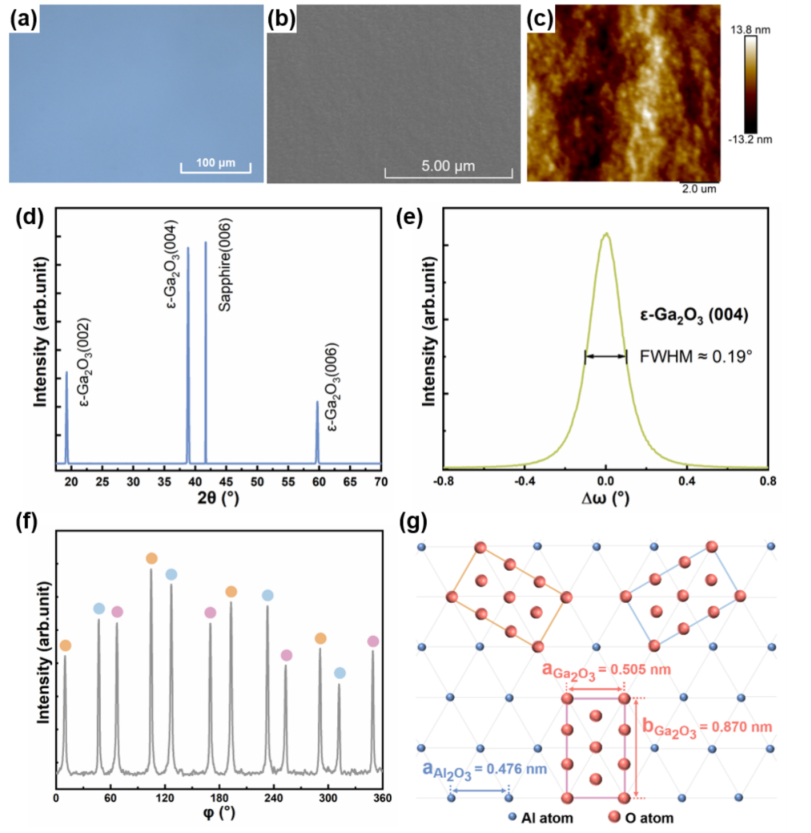
Fig. 1. (a) Optical microscope, (b) SEM and (c) AFM image of the as grown sample. (d) The XRD 2θ-scan and (e) rocking curve of ε-Ga2O3 sample grown on sapphire.(f) The XRD φ-scan of ε-Ga2O3(001) thin film. 12 diffraction peaks are divided into three sets, and each set of peaks is indicated by different colored circles. (g)Diagram of atomic arrangement between the substrate and epitaxial layer indicating three sets of rotational domains.
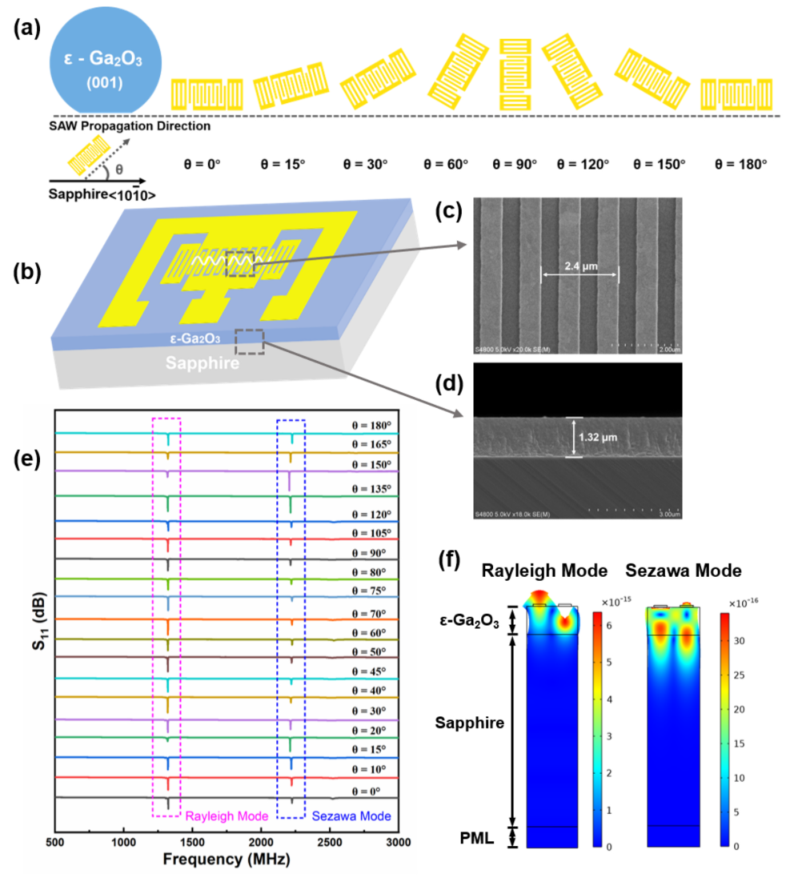
Fig. 2. (a) Schematic diagram of resonators fabricated on ε-Ga2O3(001) thin film along different directions. θ represents the angle between the SAW propagation direction and the sapphire <10-10> direction. (b-d) Structure diagram of SAW resonators. The electrode period of resonator is 2.4 μm and the thickness of epitaxial layer is 1.32 μm. (e) Scattering parameters of SAW resonators along various propagating directions. (f) The simulated SAW energy displacement at resonant fre-quencies Rayleigh mode (1295.7 MHz) and Sezawa mode (2280.9 MHz).
DOI:
doi.org/10.1016/j.apsusc.2025.163959
